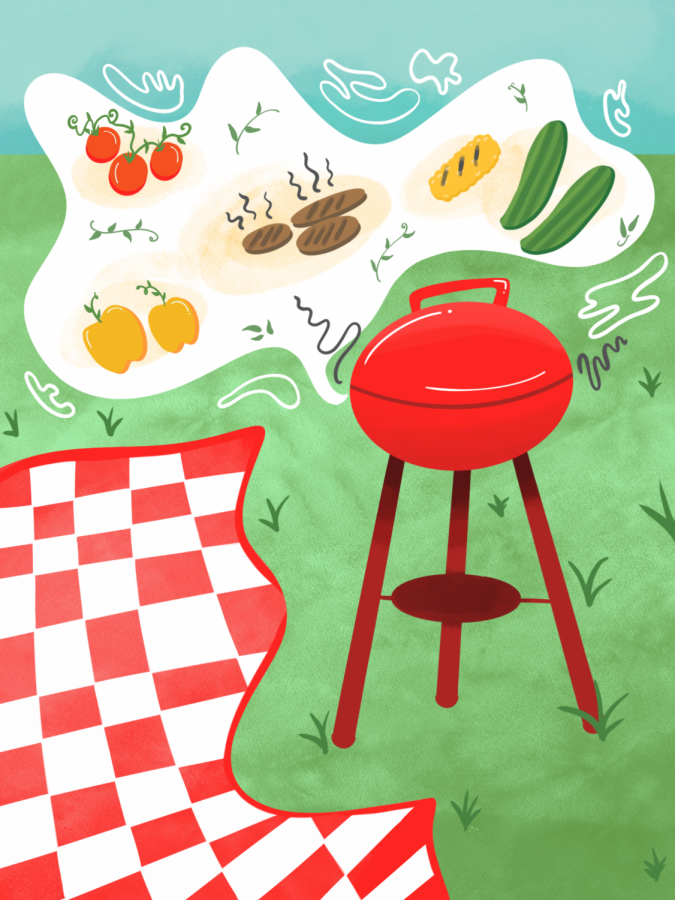- Beavers Digest
- Beavers Digest / Entertainment / Food & Drinks
- Beavers Digest / Experience
- Beavers Digest / Experience / Create
Beginner’s Barbeque
June 5, 2021
On a clear bluebird day in the heat of summer, the sweet-savory smell of barbeque passes through the breeze. Family and friends huddle around a picnic table covered in a spread of condiments and sides. There’s laughter over old twice-told stories and anecdotes from the busy week. It all revolves around the grill.
Outdoor grilling is a staple of American culture. It is a great way to get out in the fresh air and enjoy the company of the people you love, or just for yourself to switch up the home cooking routine.
But how do you get there? Grilling can seem very intimidating to the uninitiated, but there is nothing to be scared of. There are just a few things everyone should know before firing up the grill. We decided to put together the most important things to know and some quick tips to get you started on your grilling journey.
Know your grill
Whether you are grilling with a gas grill or a charcoal grill, it is important to know what you are dealing with. Every grill is different. Even two grills of the same make and model might cook differently.
The best way to know how a grill cooks is to do just that: cook. Get familiar with it by grilling something easy first. Just throw it on and see how it goes. Find the hot spots, the cool spots and dial in the correct temperature for that specific grill.
There is a lot of debate over whether gas grills or charcoal grills are better, but here’s the short of it:
Gas grills are convenient. They are ready to go in five to ten minutes and it is very easy to manage their temperatures. The downside is that they won’t give the food that cherished and highly sought after smoky charcoal flavor.
Charcoal grills are flavor enhancers. They are the source of that delicious barbeque flavor and are easier to use than you might think. The downside is that they take longer to get ready and the temperatures can be difficult to regulate.
If you have just bought a grill or are using one for the first time, here are quick guides on how to set up a charcoal grill and how to set up the propane tank for a gas grill.
If you don’t own a grill there are plenty of parks right here in Corvallis that have free public grills set up.
Know your tools
It is hard to get the job done if you don’t have the right tools. You wouldn’t try to dig a hole with a rake, right? Grilling is no different. A simple assortment of the right tools can make grilling a lot easier. Here are a few things to pick up:
Tongs are the most versatile and indispensable tool to have at your disposal. Get a long pair and use them for putting things on the grill, flipping and rearranging.
A spatula is a close runner-up to most important. Get a broad sturdy one for flipping burgers and pressing down meats.
A general rule of thumb is to never try to pick something up that is larger than the spatula. This will help avoid losing food to the ground or through the grates of the grill.
A meat thermometer is necessary to ensure that meat is done and safe to eat. There is no shame in temping your food. Not everyone is a master chef who can tell when a steak is perfectly cooked, but everyone should be positive that their steak was at the appropriate temperature before eating.
Also, if your grill doesn’t have a built-in temperature gauge, any oven thermostat placed inside the grill will work.
A grill brush keeps the grill fresh and clean. Before cooking, after the grill has been heated up, take the grill brush and give the grates a thorough scrubbing. Then after cooking give it another scrub to prevent excessive build-up.
An onion chopped in half is a great alternative that cleans and adds flavor at the same time.
Aluminum foil is the catch-all material to always have on hand. Get heavy-duty foil—yes, there is a huge difference—and use it to wrap food that has just come off the grill.
All meats should rest for at least two minutes after grilling and an aluminum foil wrap is perfect because it will keep it warm.
Know your meats
There are so many different types, cuts and variations of meat that it is impossible to keep track. It gets worse when each one takes a little bit of special treatment on the grill. Don’t stress, let’s start with the basics. Here are a few meat options that are great for beginners:
Hamburgers are the classic; the tried and true medium of grilling. Buy some pre-made patties, or some ground beef to roll your own. Simply slap them down on the grill until they are thoroughly browned, roughly three to five minutes on each side.
Chicken breast is a great lean and healthy option. Putting each breast in a Ziploc bag then using a rolling pin to flatten them out will help tenderize and produce a more even cook. Throw them on the grill for roughly five minutes on each side.
Pork chops are hearty and delicious off the grill. Pick up some sizable chops with some fat on the edges. Rubbing a little bit of lime juice on each side of the chop an hour before grilling can add some zest and even tenderize the pork. Toss them on the grill for roughly four to six minutes on each side.
Know your Veggies
Veggies are criminally underrated when it comes to grilling. Freshly grilled vegetables as their own meal, as a side or as a topping to other grilled foods is a definite crowd-pleaser.
You can’t go wrong—there are almost no vegetables that aren’t fantastic when grilled and they are quick and easy. Just drizzle them with olive oil, add salt and pepper and they are ready to go. Here are some great ones to get started with:
Asparagus: just be sure to place them perpendicular to the grates so they are not lost in the flames.
Peppers: bell peppers, poblanos, jalapenos, any of them will add some kick and color to the meal.
Eggplant is a great meat substitute. Slice lengthwise into quarter-inch slabs and grill until soft.
Portobello mushrooms are another great meat substitute. Take off the stem and place the gills side down first.
Corn with the husk still on tastes amazing off the grill. Don’t leave it on too long or you will have popcorn instead.
Know your rubs and marinades
These are the nitty-gritty, what makes or breaks the barbeque. The most common mistake when grilling is overcooking and under-seasoning. Applying a dry rub or using a marinade are simple ways to avoid the latter.
There are a multitude of prepackaged or pre-bottled options at any grocery store, but making your own is the perfect way to customize the flavor to your own preference. Here is a breakdown of each method:
Dry rub is just a fancy way of saying seasoning. It is just a thorough layer of whatever seasoning you like. Pat the meat down with a paper towel until it is dry, apply the seasoning, then rub it in with your hands. Make sure you do both sides and the edges, then wash your hands afterward. Let it sit in the fridge for at least 15 minutes or up to 12 hours.
Marinade lets the flavor soak in. Take a gallon size Ziploc bag and place your meat inside, add the marinade, then get as much air out as possible and seal it. The amount of time meat can be left in marinade varies based on the type, but one to three hours is more than enough.
Never use the leftover marinade from the bag. Always set about half the marinade aside ahead of time for spreading on the meat while it is cooking. And show the veggies some love by spreading some on them as well.
If you do want to make your own dry rub or marinade, here is a sweet and spicy pork chop dry rub recipe and a zesty chicken fajita marinade recipe. Don’t be shy about experimenting either.
Know your safety protocols
Now for the boring part: safety. No wait, this is actually very important, so pay attention! It is all fun and games until someone gets hurt. When it comes to grilling, the dangers are serious but are easily avoidable. Here are some tips to keep everyone safe while grilling:
Check for animals.
Small animals like birds and mice love to build nests inside the security of outdoor grills. If your grill hasn’t been used in a long time, go through it to make sure no little critters will be injured while you are grilling.
Move the grill to an open area.
Having your grill too close to the house, under an awning or low-hanging tree branch is an easy way to start a fire. Move the grill to an open area where there is nothing above it and it is sure to not be knocked over. Always know where the closest fire extinguisher is, just in case.
Prevent against a grease fire.
Excessive oils and fats from foods on the grill can drip off and start a grease fire. Flare-ups are common but when it turns into a blazing grease fire, it is important not to panic. Never use water to put out a fire on your grill. Grab the closest fire extinguisher or douse the flames with baking soda.
Check your temps.
As the grillmaster, it is your job to provide everyone with safe-to-eat food. Foodborne diseases are no joke. Pull out that handy meat thermometer to ensure all meat aligns with the USDA’s safe minimum internal temperature chart.
Avoid cross-contamination.
Anything that touches raw meat is contaminated. Keep veggies on the opposite side of the grill as the meats, and separate them entirely before putting them on the grill. Wash your hands after any contact with raw meat. Never use the same tools for raw meat and cooked meat. Have a different set or wash the tools afterward.
That is all there is to it. Now all you have to do is get some friends together and get grilling!






